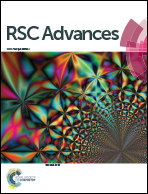Development, optimization and evaluation of tinidazole functionalized electrospun poly(ε-caprolactone) nanofiber membranes for the treatment of periodontitis
Abstract
The aim of this study was to alleviate shortcomings in the treatment of periodontitis by electrospinning of a novel biodegradable poly(ε-caprolactone) (PCL) based nanofiber membrane functionalized with tinidazole (TNZ). Box–Behnken design was employed for evaluating influence of formulation and processing variables on entrapment efficiency (EE) and diameter of nanofiber. The optimum batch selected by desirability approach was subjected to physicochemical characterization such as FTIR, DSC and PXRD which revealed entrapment of drug in a molecular dispersion devoid of any chemical interaction with the excipients. Electron microscopy showed smooth structure in nanometre range, without any visible sign of fiber break-up or disruption within the nanofiber membrane. Optimized TNZ-PCL nanofiber membrane exhibited a diameter of 147.6 ± 7.6 nm and EE 84.36 ± 1.5%. In vitro release study and antibacterial study demonstrated sustained drug release for up to 20 days, depending upon the drug to polymer ratio and solvent composition. Further, reduction of contact angle (from 123.6 ± 2.8 to 57.2 ± 1.9) revealed that incorporation of TNZ enhanced the hydrophilicity of the nanofiber membrane which would facilitate its adhesion to the site of action and instigate proliferation of cells. MTT assay and CLSM study suggested that nanofiber membrane showed no cytotoxicity on mouse fibroblasts (L-929 cell lines). Moreover, in vivo study by ligature-induced periodontitis in rats confirmed that TNZ loaded nanofiber membrane can significantly (p < 0.05) improve continuity of epithelium and transseptal fiber of interdental papilla in comparison to tinidazole gel.


 Please wait while we load your content...
Please wait while we load your content...